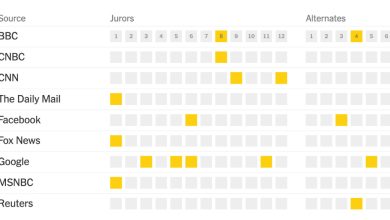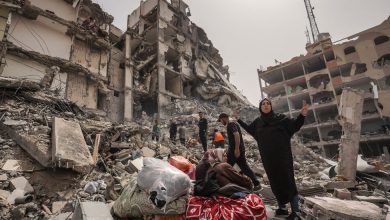As Adams Toughens on Crime, Some Fear a Return to ’90s Era Policing

In Mayor Eric Adams’s first three months in office, New York City has been marred by shootings and hate crimes, a fatal subway shoving in Times Square and other high-profile killings. Now, the mayor is testing just how much a liberal city is willing to empower its police.
Despite longstanding controversy around “broken windows” policing — enforcement of low-level offenses in an effort to prevent more serious crimes — the Police Department this week announced a new initiative designed to enforce so-called quality-of-life matters, aimed at issues including public drinking, public urination and “dice games that lead to disputes and shootings.”
The tactic gained significant attention in the 1990s under the leadership of Mayor Rudolph W. Giuliani and his police commissioner, William J. Bratton, and has been deployed to varying degrees in other mayoral administrations. The new measure will initially be utilized in neighborhoods experiencing high rates of gun violence in Brooklyn and the Bronx, some of the same areas where Black and Hispanic New Yorkers were disproportionately affected by stop-and-frisk police tactics that were deemed unconstitutional.
After years of national Democratic efforts to distance themselves from ’90s-style tough-on-crime tactics, Mr. Adams is now pushing New York into a new era of more aggressive law enforcement, even with the city far safer than in earlier decades.
Mr. Adams and Gov. Kathy Hochul havelaunched plans to have police officers conduct more regular sweeps of the subway system, along with efforts to combat homelessness there. Earlier this month, the Police Department unveiled a revamped version of a police unit focused on getting guns off the street; earlier incarnations of the unit, which were associated with a disproportionate number of fatal shootings by the police, were disbanded.
The return of the unit, along with the renewed emphasis on quality-of-life crimes, were among the clearest signs yet of the Adams administration’s efforts to broaden the powers of law enforcement.
Mr. Adams, a former police captain who spoke out against police brutality and the abuse of stop-and-frisk, has stressed that he will not tolerate police misconduct.
“I should get some form of credit that I’m not going to allow my life work to be desecrated by police officers who are abusive,” Mr. Adams said in an interview.
But some New York officials fear that the city is moving closer to the Giuliani era, whichcritics associate with discriminatory overpolicing.
“I feel like I’m in a time warp,” said Assemblywoman Latrice M. Walker, whose Brooklyn district includes neighborhoods that are slated for greater quality-of-life-issue enforcement. “I know that the calendar says 2022. But a return to ‘broken-windows’ policing makes me feel like it’s 1994 and Rudy Giuliani is the mayor, stop-and-frisk is out of control, and the N.Y.P.D. is harassing Black and brown New Yorkers.”
Across the country, the politics of public safety have been dramatically reordered over the last two years, first by social justice protests following the police killing of George Floyd, and then by a rise in gun violence amid the pandemic. Nowhere has that trajectory been clearer than in New York City, where Mr. Adams, the city’s second Black mayor, won last year by promoting both safety and racial justice.
His police commissioner, Keechant L. Sewell, insisted in a statement that the new quality-of-life initiative was “NOT a return” to stop-and-frisk, and later said the enforcement push would narrowly focus on the people and behaviors driving crime. It remains to be seen whether the initiative will be picked up by the city’s district attorneys, who have long been reluctant to prosecute low-level offenses.
And Mr. Adams, who has relayed his own experience with police brutality and sought to battle injustice from within the Police Department, said that technologies like cameras would help guard against police misconduct, and that there would be efforts to get community input around enforcement of quality-of-life issues.
“Prior to Mayor Giuliani being mayor, I talked about, that communities of color in particular, deserve the same quality of life as affluent communities,” he said. “The residents of these communities have been saying we want the quality of life we deserve, and we can get it without being abusive.”
Police officials said the new plan is designed to address a sharp pandemic-era increase in quality-of-life complaints for things like public drinking and loitering. Chief Michael LiPetri, who is in charge of crime control strategies, said that during warmer months, nearly a third of shootings are tied to disorder and low-level crime.
“We are focusing on the people, the places, the things that lead to criminality and lead to violence and deteriorate the quality of life for everyday New Yorkers,” Commissioner Sewell said.
But both supporters and skeptics of the policing plan have raised concerns about the safety risks for officers, and the possibility of racial profiling of young Black and Hispanic men in the neighborhoods targeted for enforcement and most afflicted by violence.
“Giuliani used quality-of-life enforcement as a pretext for racial stops and Bloomberg doubled down on it,” said Jenn Rolnick Borchetta, the managing director of impact litigation at the Bronx Defenders, and a lawyer for the plaintiffs who sued the city over its stop-and-frisk tactics. She added that the pivot to quality-of-life offenses amid a spike in serious crime in the 1990s “is the same two-step that’s happening right now.”
In 2016, amid falling crime rates, the City Council gave police officers discretion to use civil summonses, instead of criminal ones, for petty crimes. Enforcement fell dramatically as some officers opted not to punish the offenses at all. In 2019, the State Legislature passed measures requiring the police to release certain arrestees with written orders to appear in court, known as desk-appearance tickets, instead of booking them.
But crime has risen, and the new plan requires officers to step up enforcement against activities that the police say often precede or accompany shootings, like dice games, drug sales and unlicensed driving. That includes issuing more criminal summonses and making more low-level arrests where city rules and state law give officers discretion to do so, police officials said.
Neighborhood Coordination Officers, a role created to rebuild police relationships withcommunities following Eric Garner’s death at the hands of police on Staten Island, will no longer be required to conduct casework, like canvassing for surveillance video, two police officials said.
That frees the officers up to work with local residents to find more ways to address the kinds of complaints that led to Mr. Garner’s fatal encounter with officers who had been sent to arrest him for selling loose cigarettes.
But one supervisor, who was not authorized to speak and asked for anonymity, told The Times he worried that the change might have a negative impact on the department’s ability to solve crimes at a time when clearance rates were already low.
Police union officials said they appreciated the backing of the mayor and police commissioner in addressing low-level crime and disorder. But they warned that asking officers to ramp up enforcement without stronger consequences from prosecutors, judges and lawmakers would embolden criminals.
Darcel D. Clark, the Bronx district attorney, dismissed approximately 6,000 criminal summonses for marijuana offenses last year. She said her office no longer prosecuted such cases because the offenses were not a threat to public safety and burdened people with criminal records. But on Thursday, she declined to say how she would respond to the quality-of-life initiative.
“What I did last year was based on what I knew then,” she said. “I can’t speak on what’s going to happen in the future.”
Mr. Adams has certainly embraced a more aggressive policing style than his predecessor, Bill de Blasio, who oversaw the disbanding of plainclothes anti-crime units amid social justice protests, and who sought to reduce policing encounters as crime fell before the pandemic.
At the same time, Mr. Adams has pushed for both investments in social services and in law enforcement, backing, for instance, the deployment of mental-health workers to New York’s subway, as well as an expansion of the police presence there.
“He has continued to try to change things and restore some order to the street,” said Tom Harris, the president of the Times Square Alliance, who said he had noticed both social services outreach and “more proactive enforcement.”
Some New Yorkers may want him to do more, including those in New York’s business community with which Mr. Adams has been closely aligned. An online poll conducted on behalf of the business-aligned Partnership for New York City found that 84 percent of metro-area employees surveyed said conditions in the city had worsened over the past two years.
And on Friday afternoon, Mr. Adams’s team abruptly summoned a reporter to a closed-press virtual meeting that the mayor was holding with people who have lost family members to violence.
“I have been just getting my butt kicked by the loudest,” the mayor said at the meeting, alluding to his critics. “And hearing from you today is just telling me, you know, ‘Young man, stay the course.’”
Dana Rubinstein contributed reporting.




